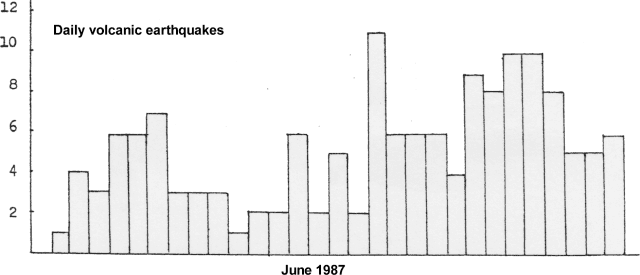Report on Arenal (Costa Rica) — June 1987
Scientific Event Alert Network Bulletin, vol. 12, no. 6 (June 1987)
Managing Editor: Lindsay McClelland.
Arenal (Costa Rica) Stronger explosions; ashfalls to 20 km W
Please cite this report as:
Global Volcanism Program, 1987. Report on Arenal (Costa Rica) (McClelland, L., ed.). Scientific Event Alert Network Bulletin, 12:6. Smithsonian Institution. https://doi.org/10.5479/si.GVP.SEAN198706-345033
Arenal
Costa Rica
10.463°N, 84.703°W; summit elev. 1670 m
All times are local (unless otherwise noted)
During the first half of June, activity was at a relatively low level, with an average of four explosions daily (figure 12). A moderate increase was recorded beginning 17 June, with several significant explosions: 27 June, 1455; 28 June, 1503; and 29 June, 1655. These ejected substantial quantities of vapor, ash, and blocks. Ash clouds reached Tilaran, 20 km W of Arenal. Costa Rican geologists noted that such increases in activity have been a normal part of the current eruption.
 |
Figure 12. Daily number of Arenal's volcanic earthquakes recorded at station FOR, June 1987. Courtesy of ICE. |
Geological Summary. Conical Volcán Arenal is the youngest stratovolcano in Costa Rica and one of its most active. The 1670-m-high andesitic volcano towers above the eastern shores of Lake Arenal, which has been enlarged by a hydroelectric project. Arenal lies along a volcanic chain that has migrated to the NW from the late-Pleistocene Los Perdidos lava domes through the Pleistocene-to-Holocene Chato volcano, which contains a 500-m-wide, lake-filled summit crater. The earliest known eruptions of Arenal took place about 7000 years ago, and it was active concurrently with Cerro Chato until the activity of Chato ended about 3500 years ago. Growth of Arenal has been characterized by periodic major explosive eruptions at several-hundred-year intervals and periods of lava effusion that armor the cone. An eruptive period that began with a major explosive eruption in 1968 ended in December 2010; continuous explosive activity accompanied by slow lava effusion and the occasional emission of pyroclastic flows characterized the eruption from vents at the summit and on the upper western flank.
Information Contacts: R. Barquero and Guillermo Alvarado, ICE.

